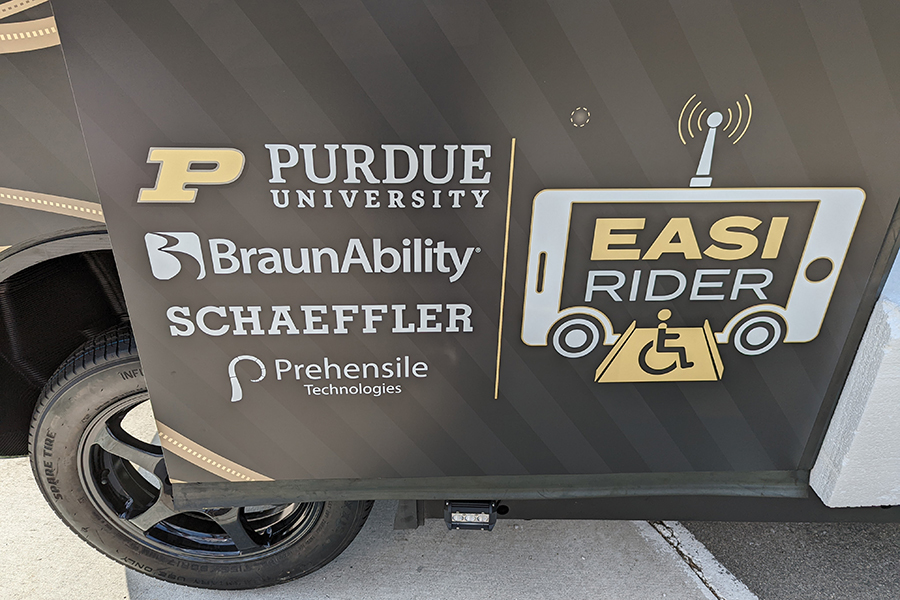Duerstock-Pitts team named winner of $1M first place prize in DOT's Inclusive Design Challenge
A team of Purdue engineering professors was named the winner of the $1 million 1st place prize on July 26 in the 2020 U.S. Department of Transportation (DOT) Inclusive Design Challenge (IDC). The contest is aimed at improving transportation access to persons with disabilities and individuals with mobility challenges.

The team plans to use the prize money to establish a center on accessible design for future transportation and other technologies.
A stream cast of the ceremony with remarks from Secretary of Transportation Pete Buttigieg is today (July 26) at 2 pm ET, which coincides with a celebration of the 32nd anniversary of the ADA.
DOT created the $5 million challenge that focused on innovative design solutions to enable people with physical, sensory, and cognitive disabilities to use automated vehicles (AV) to access jobs, health care and other critical destinations.
In June, Duerstock, professor of practice in industrial engineering and biomedical engineering, and Brandon Pitts, assistant professor of industrial engineering, demonstrated their prototype of the Efficient, Accessible and Safe Interaction in a Real Integrated Design Environment for Riders with disabilities (EASI RIDER) and offered a realistic demonstration that allowed people to physically interact with a life-sized representation of their accessible Automated Driving System-Dedicated Vehicle (ADS-DV).
The team commends the DOT’s foresight in acknowledging that autonomous vehicles are the future of transportation.
“People with disabilities who have difficulty with everyday transportation needs can be major stakeholders in this emerging technology,” Duerstock said. “However, for autonomous transportation to be completely inclusive for all types of passengers, accessible design must be considered in how people with disabilities enter and interact with the AV.”
Their goal in developing EASI RIDER involved demonstrating how their design works and helps passengers with disabilities. With prize money from Stage 2 of the competition, the team developed a realistic demonstration that allowed people to physically interact with a life-sized representation of their accessible Automated Driving System-Dedicated Vehicle (ADS-DV).
“The platform consists of an ADS-DV ramp design, an automatically deploying ‘Smart Ramp’, an automated wheelchair securement system, and an on-board user-interface that provides accessibility features that cater to people with a wide range of disabilities,” Pitts explained.
The project offers an integrated inclusive design that involves multiple elements necessary for a traveler with a disability to enter the vehicle, maneuver and be seated, control all functionality of an AV, and disembark at the designated destination independently and safely.
“We worked with several industry partners to develop the life-sized, operational demonstration platform,” Duerstock said, “tapping our partners’ expertise in various areas, including wheelchair entry and exiting; Smart Ramp deployment and wheelchair securement; alternative vehicle controls; vehicle platforms; powered wheelchair innovations that incorporate robotics and camera systems; and speech-generating devices.”
Pitts said the other design criterion was efficiency. “Current modes of accessible transportation often do not provide an easy or pleasant experience,” he said. “Persons with disabilities frequently feel as if they are delaying or inconveniencing other passengers. They also may not feel comfortable in reaching their destinations, or even feel safe while traveling. In general, there is a lot of anxiety associated with travel, even if everything goes well.”
To address these concerns, in addition to state-of-the-art technological solutions, the team focused on applying human factors and systems engineering approaches to this challenge.
The two have been interested in this technology for a while now. Duerstock was fortunate to have had prior research collaboration with BraunAbility, a global leader in performing vehicle conversions for wheelchair-accessible vehicles and developing wheelchair lifts and ramps.
“What BraunAbility brings to the table is a way to ensure that wheelchair users can enter the vehicle and be secured without requiring assistance,” Duerstock said.

“BraunAbility is very excited to be a part of the team led by Brad Duerstock and Brandon Pitts for the DoT Inclusive Design Challenge. We have worked with Professor Duerstock on several projects over the last five to seven years and know him to be an expert in the field of accessibility for individuals with disabilities,” said Phillip Bell, senior director of Global Corporate Strategy for BraunAbility. “We are looking forward to helping influence the design of future autonomous vehicles to maximize their usefulness for wheelchair users, and, in turn, help them live full, productive lives.”
To further develop a base of industry partners, BraunAbility put Duerstock and Pitts in contact with Local Motors and Schaeffler, companies also considered industry leaders in the area of accessible and autonomous transportation. Prehensile Technologies, a startup founded at Purdue based on developing assistive technology solutions, also assisted in various types of vehicle modifications.
Schaeffler manufactures high-precision components and systems for drive train and chassis applications as well as products across the full bandwidth of electrification options. With its partner Schaeffler Paravan, the company provided its patented “Space Drive” technology for the design challenge to allow accessible control of secondary functions like ramp deployment, lighting control and temperature control.
“Since Schaeffler is in the mobility space, and Space Drive was founded to solve mobility challenges for people with disabilities, this engagement with Purdue only made sense for us,” said Noel Marshall, senior account executive with Schaeffler.
In addition, Purdue has a research alliance with Ford Motor Company, and one of its technical leaders in human factors and accessibility within the Ford AV LLC provided guidance to the team early on regarding autonomous transportation, “an area that Ford also has been interested in pursuing,” Duerstock said. Pitts added “The knowledge provided by this expert was invaluable in helping to shape the design of EASI RIDER.”
